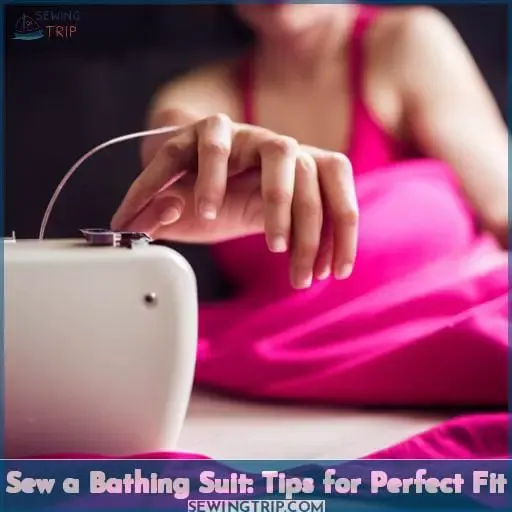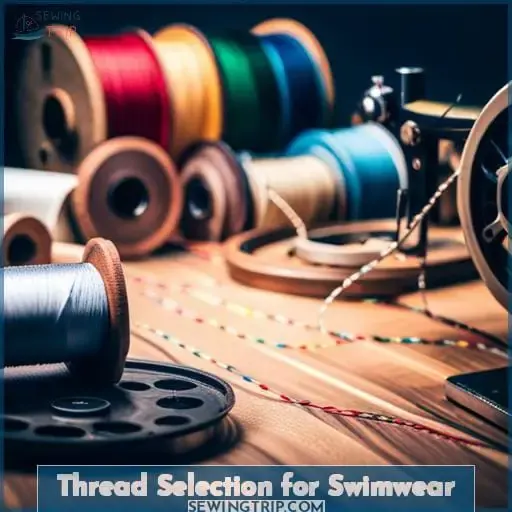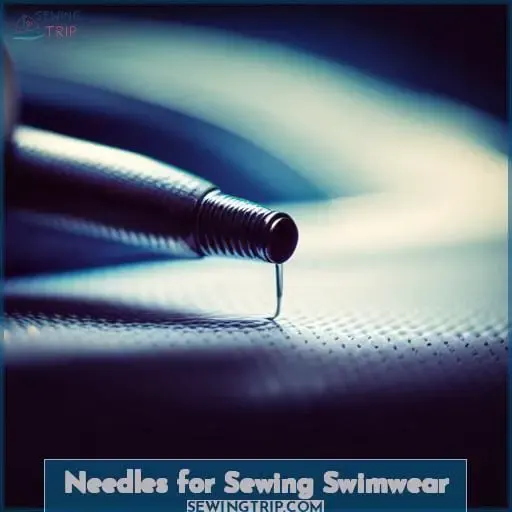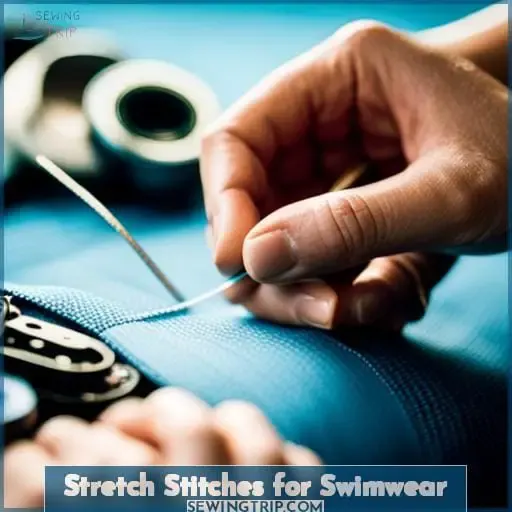This site is supported by our readers. We may earn a commission, at no cost to you, if you purchase through links.
 Imagine strutting along the beach in a bathing suit that fits you perfectly, embracing your unique style and body shape.
Imagine strutting along the beach in a bathing suit that fits you perfectly, embracing your unique style and body shape.
With our tips for sewing a bathing suit, you can create a one-of-a-kind swimsuit that makes you feel confident and empowered.
From choosing the right size to selecting the best fabric and elastic, we’ll guide you through every step of the process.
Get ready to dive into this exciting DIY project and unleash your inner fashion designer!
Table Of Contents
Key Takeaways
- Find your correct measurements.
- Choose the right fabric and lining for swimwear.
- Use the appropriate elastic for durability and comfort.
- Use a sharp rotary cutter and stretch stitches for precise sewing.
Choose the Right Size
When sewing a bathing suit, it’s crucial to choose the right size for a perfect fit.
- Finding your correct measurements
- Selecting the corresponding pattern size
- Understanding how to grade between sizes
By taking these steps, you can ensure that your handmade bathing suit will flatter and accentuate your body in all the right ways.
Finding the correct size
To achieve the perfect fit, start by determining your measurements and selecting a pattern that matches your body size.
- Consider negative ease for a close fit.
- Choose swimsuit patterns with size range options.
- Customize sizes for upper and lower body measurements.
- Grading between sizes can enhance overall fit.
Choosing suitable materials
When choosing suitable materials for your bathing suit, consider the desired size and fit.
- Opt for stretchy fabric with good recovery.
- Align patterns correctly.
- Choose durable lining options and elastic that can withstand chlorine exposure.
Don’t forget essential sewing tools!
Understanding pattern placement
You frequently need to pay attention to pattern placement when sewing a bathing suit for the perfect fit.
Understanding the importance of grainline, precise placement, and cutting precision is key to achieving optimal results.
Select the Best Fabric
When selecting fabric for your bathing suit, opt for a nylon and spandex blend to ensure adequate stretch.
Look for fabrics with at least 10% spandex content.
Additionally, consider using chlorine-resistant elastic options and power mesh fabric to provide extra support and durability in your swimwear creations.
Nylon and Spandex Blend
Choose a swimsuit fabric with at least 10% spandex for adequate stretch.
Consider durability concerns and opt for nylon and spandex blend fabrics.
Ensure the lining material provides support, while elastic longevity is prioritized.
Pay attention to pattern precision when selecting swimming suit fabrics.
Chlorine-resistant elastic options
To ensure the longevity of your handmade bathing suit, opt for chlorine-resistant elastic options.
Consider using a cotton/poly blend or rubber swim elastic with a flat profile.
Pair it with 8% spandex fabric and polyester thread for durability.
Use stretch needles and skip the iron to maintain soft stretch.
Power mesh for support
To enhance the strength and support of your handmade swimsuit, consider incorporating power mesh fabric.
Power mesh is perfect for shaping, providing control and durability while still offering stretch for a comfortable fit in your bathing suit.
Find the Perfect Lining
Now let’s move on to finding the perfect lining for your handmade bathing suit.
-
Nylon vs. Polyester lining:
- Consider 100% nylon lining (Helenca lining) for a traditional feel.
- Opt for self-lining with swimsuit fabric for simplicity.
-
Self-lining vs. Power mesh:
- Utilize power mesh for added strength and support in swimwear.
- Be cautious with sizing adjustments when incorporating power mesh.
-
Precise pattern placement:
Make sure to pay attention to grainline and the direction of the greatest stretch when placing your pattern pieces, ensuring that you avoid any misplacement of design elements.
4.Avoid skipped stitches: Use fresh stretch needles suitable specifically designed high-spandex fabrics and test stitch settings along scrap fabric before starting on your actual project.
By following these tips, you’ll be able to find a suitable lining option that enhances both comfort and functionality while sewing your own bathing suit masterpiece!
Use the Right Elastic
You’ll need to use the right elastic for a well-fitted bathing suit.
When it comes to choosing elastic, consider factors such as width and stretch.
- Opt for a 4-way stretch elastic that can move comfortably with your body while maintaining its shape.
- Look for chlorine-resistant options to ensure longevity and durability against harsh pool chemicals.
- Rubber swim elastics, like those from trusted brands, are ideal due to their flat profile and ease of use in swimwear construction.
- Additionally, select colorfast elastics that won’t fade or bleed when exposed to water or sunlight.
Remember to care for your swimsuit by rinsing it after swimming and handling the fabric gently during sewing using appropriate needles and stitches.
| Elastic Features | Recommendations |
|---|---|
| Width | Choose an appropriate width based on your pattern’s requirements |
| 4-way stretch | Opt for an elastic that stretches both horizontally and vertically |
| Type | Select chlorine-resistant rubber swim elastics from reputable brands |
| Color | Ensure colorfastness of the elastic so it doesn’t fade or bleed over time |
| Care | Rinse your swimsuit after swimming; handle the fabric carefully during sewing |
By using these tips when selecting the right type of elasticity material, you’ll be able create not only beautiful, fashionable bathing suits, but also ones which fit perfectly, enhancing liberation and empowering you with mastery over this particular fashion style.
Thread Selection for Swimwear
When sewing a bathing suit, it’s important to select the right thread for optimal results.
Consider choosing nylon or polyester thread that’s resistant to chlorine and salt. These types of threads will ensure durability and longevity in your swimwear creations.
Additionally, using power mesh for added support can enhance the overall fit of your swimsuit design without compromising style or comfort.
Nylon vs. Polyester:
When choosing thread for sewing swimwear, consider the differences between nylon and polyester options.
Nylon offers durability and recovery, while polyester provides stretch and colorfastness.
Choose based on your desired qualities and budget.
Chlorine-resistant elastic:
To ensure the longevity of your handmade bathing suit, choose chlorine-resistant elastic for secure and durable seams.
Opt for elastic that offers:
- Durability
- Resistance to chlorine and salt
- Excellent recovery
- Colorfast shades
- Stretchability with a four-way stretch design
- Ease of use with its flat profile
Power mesh for support
For added strength and support in your swimwear, opt for power mesh.
Power mesh provides:
- Shape retention
- Support
- Shaping
- Control
It’s perfect for creating a flattering fit that gives you the confidence to conquer the waves.
Needles for Sewing Swimwear
To ensure a successful sewing project, you’ll need the right needles for sewing swimwear.
- Stretch Needles:
- These specialized needles are designed for high-spandex fabrics commonly used in swimwear.
- They prevent skipped stitches and holes, ensuring smooth and secure seams.
- Ballpoint Needles:
- Ideal for dense knits like swim fabric, ballpoint needles have rounded tips that slide smoothly through the material without snagging or shredding.
- Schmetz Stretch Needles:
- Specifically made for stretchy materials like spandex and jersey, these size 14 machine needles deliver perfect stitches on flexible fabrics such as bathing suits or activewear.
- Walking Foot:
- When working with slippery or bulky fabrics in swimwear construction, using a walking foot can help facilitate even movement of fabric layers during stitching.
Choose the needle type that best suits your needs to achieve professional-looking results when sewing your own swimsuit.
Cutting Techniques With Rotary Cutter
Cut the pieces for your bathing suit with precision by using a rotary cutter and pattern weights.
The rotary cutter allows you to make clean, smooth cuts on slippery fabrics without distorting the shape of your pattern pieces.
To ensure accuracy, place your fabric on a cutting mat and line up the grainline of the fabric with the edge of the mat.
Cut along the cutting direction indicated on your pattern, making sure to include seam allowances.
Once you have cut all your pieces, remember to press them before sewing to eliminate any wrinkles or creases caused during cutting.
| Cutting Techniques With Rotary Cutter |
|---|
| – Use a sharp rotary cutter for precise cuts |
| – Place fabric on a self-healing cutting mat |
| – Align grainline with edge of mat |
| – Pressing after each cut |
Don’t forget that working with slippery fabrics can be tricky! To prevent shifting during cutting, use pattern weights or heavy objects like cans or books to hold down your fabric securely. This will help you maintain accuracy in aligning and cutting each piece according to its specific shape and size requirements.
Once all of your swimsuit pieces are cut out accurately using these techniques,
you’ll be ready for smooth sailing as you sew them together into one fabulous garment.
Stretch Stitches for Swimwear
Now that you’ve mastered the cutting techniques with a rotary cutter, it’s time to move on to the next step: stretch stitches for swimwear. These specialized stitches will ensure durability and flexibility in your handmade bathing suit.
Here are three essential types of stretch stitches for swimwear:
- Zigzag Stitch: This classic stitch is perfect for joining seams in swimwear fabric. It allows for some give while maintaining strength.
- Lightning Stitch: Also known as a triple straight stitch, this powerful stitch creates multiple parallel lines of stitching, adding extra reinforcement to critical areas like leg openings or waistbands.
- Walking Foot: If you have one available, using a walking foot attachment on your sewing machine can help feed slippery fabrics evenly through the machine.
So go ahead and experiment with these different stretch stitches until you find what works best for your swimsuit project!
Handling and Care Tips
As you continue sewing your bathing suit, it’s important to handle and care for the fabric with precision and attention.
- Rinse after swimming:
After a day at the beach or pool, make sure to rinse your bathing suit thoroughly with cool water. This helps remove any chlorine or salt residue that can damage the fabric.
- Avoid harsh detergents:
When washing your swimsuit, use a gentle detergent specifically designed for delicate fabrics. Harsh chemicals can cause fading and deterioration over time.
- Air dry flat:
Instead of using a dryer, let your bathing suit air dry flat on a clean towel or drying rack. This prevents stretching or misshaping while allowing it to retain its original fit.
4.Avoid direct sunlight:
Prolonged exposure to direct sunlight can fade colors and weaken the fibers of your swimsuit material. Always store them in shade when not wearing them.
5.Store in a cool ,dry place :
Excessive heat may affect elasticity so always keep swimwear items stored away from high temperatures such as those found near radiators , heaters etc.
Frequently Asked Questions (FAQs)
What are some common mistakes to avoid when sewing a bathing suit?
Avoid common mistakes when sewing a bathing suit to achieve mastery.
Don’t stretch or pull the fabric.
Use proper stitch settings for durability.
Pay attention to topstitching details.
Embrace liberation through flawless swimwear creations!
Can I use regular thread instead of polyester thread for sewing swimwear?
Yes, regular thread can be used for sewing swimwear, but polyester thread is recommended for its resistance to chlorine and salt.
How do I determine the grainline and direction of greatest stretch in my fabric?
To determine the grainline and direction of greatest stretch in your fabric,
Align the selvage with the desired grainline.
Then, gently stretch the fabric horizontally and vertically to identify which direction offers more resistance.
Is it necessary to use a serger when sewing a bathing suit?
A serger isn’t necessary when sewing a bathing suit, but it can complement your sewing machine.
It adds a professional finish to seams and helps prevent fabric fraying.
What are some tips for achieving precise pattern placement in swimwear?
Achieving precise pattern placement in swimwear is crucial for a flattering and professional result.
Consider the grainline and direction of stretch, ensuring accurate alignment to avoid design misplacement.
Mastering this skill will elevate your swimsuit sewing game!
Conclusion
Embrace your inner fashion designer and create a one-of-a-kind bathing suit that fits you perfectly.
With our tips for sewing a bathing suit, you can confidently strut along the beach in a swimsuit that showcases your unique style and body shape.
From choosing the right size and fabric to selecting the best elastic and thread, we’ve got you covered every step of the way.
Dive into this exciting DIY project and unleash your creativity as you sew your own fabulous bathing suit.















